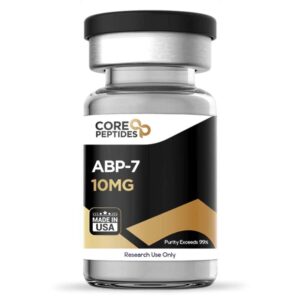Description
Mechanism of Action
CJC-1295 DAC binds to GHRH receptors on somatotroph cells in the anterior pituitary. This binding triggers conformational changes in the receptor, activating G-proteins that induce secondary messenger production, such as cAMP and IP3. These messengers stimulate protein kinases, which phosphorylate transcription factors that modulate the expression of genes involved in GH synthesis and secretion. The cumulative effect is enhanced release of growth hormone into circulation, which in turn stimulates hepatic production of insulin-like growth factor 1 (IGF-1), promoting systemic anabolic and regenerative effects.
Physiological Effects and Research Findings
-
Growth Hormone and IGF-1 Modulation
-
CJC-1295 DAC has been shown in animal and human studies to increase GH secretion 2- to 10-fold over several days.
-
Elevated GH stimulates IGF-1 production in liver and peripheral tissues, with observed increases ranging from 1.5- to 3-fold, supporting muscle protein synthesis, bone growth, and tissue repair.
-
-
Body Composition and Muscle Mass
-
Preclinical studies suggest CJC-1295 DAC may increase lean muscle mass and maintain bone density, while potentially stabilizing or reducing fat mass.
-
Studies in GHRH knockout mice indicated preservation of lean mass and normalized subcutaneous fat levels after exposure to the peptide.
-
-
Pulsatile GH Release
-
CJC-1295 DAC may enhance GH pulsatility, mimicking the natural physiological secretory pattern of the hormone, which is associated with improved metabolic, cardiovascular, and musculoskeletal outcomes.
-
-
Molecular and Cellular Effects
-
Exposure to CJC-1295 DAC has been linked to increased pituitary RNA and GH mRNA levels, suggesting proliferation of somatotroph cells.
-
IGF-1 produced via GH stimulation activates the JAK-STAT signaling pathway, further mediating anabolic and regenerative processes in multiple tissues.
-
-
Potential Benefits
-
Muscle hypertrophy: Supports collagen synthesis and muscle tissue growth.
-
Bone density support: May enhance bone mass and reduce fracture risk.
-
Fat metabolism: Encourages use of adipose tissue for energy.
-
Sleep and cognitive support: Indirectly influenced via GH and IGF-1 signaling.
-
Pharmacokinetics
-
Half-life: 6–8 days (with DAC)
-
Duration of elevated IGF-1 levels: Up to 2–4 weeks after repeated exposure
-
Stability Enhancements:
-
2nd position: L-alanine → D-alanine (resists enzymatic degradation)
-
8th position: Asparagine → Glutamine (reduces amide hydrolysis)
-
15th position: Glycine → Alanine (enhances bioactivity)
-
27th position: Methionine → Leucine (prevents oxidation)
-
Research Applications
CJC-1295 DAC is widely used in preclinical and clinical research to study:
-
GH-IGF-1 axis modulation
-
Muscle and bone regeneration
-
Metabolic and anabolic effects
-
Pituitary somatotroph proliferation
-
Potential interventions for aging, muscle wasting, and metabolic disorders
Note: CJC-1295 DAC is intended for research purposes only and is not approved for human therapeutic use. Researchers must adhere to applicable safety regulations and institutional guidelines when handling the peptide.
References
-
Jetté L, Léger R, et al. Endocrinology. 2005;146(7):3052–3058. doi:10.1210/en.2004-1286
-
Henninge J, Pepaj M, et al. Drug Testing and Analysis. 2010;2(11-12):647–650. doi:10.1002/dta.233
-
Sinha DK, Balasubramanian A, et al. Transl Androl Urol. 2020;9(Suppl 2):S149–S159. doi:10.21037/tau.2019.11.30





Reviews
There are no reviews yet.